The
Goodells also benefited in many ways from their employment with
Millers Falls Co.
First, they had an excellent "on the job" training in a
production environment. They also had an exposure to many
new patents acquired by Millers Falls Co. and participated in
design and production of many new tools.
The Brest Drill No. 12 is a good example.
It was developed and produced since 1873, and originally equipped with Barber's chuck. In 1887 the drill received
a new chuck,
developed and patented by Albert D. and named in Millers Falls
Co.'s catalogs as a
"Secondary Grip."
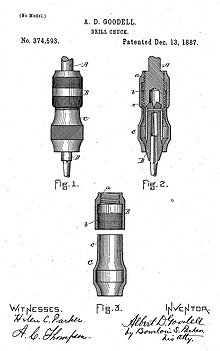 The chuck was
based on patent
No. 374,593, dated December 13,
1887. Albert D. designed a chuck that could mitigate
gripping issues with "irregular-shaped shanks". He
described his new solution as follows:
The chuck was
based on patent
No. 374,593, dated December 13,
1887. Albert D. designed a chuck that could mitigate
gripping issues with "irregular-shaped shanks". He
described his new solution as follows:
"It is well known that the ordinary chuck
now in use of this class does not hold round-shanked
articles with sufficient grip to prevent shifting or turning
in the jaws when in use. The special object of my present
invention is therefore to overcome this difficulty by so
arranging the different parts of the chuck that a much more
powerful force can be brought to bear upon the jaws which
hold the shank of the tools or implement used."
"The operation of this chuck is as
follows: The shank of the tool is inserted between the jaws.
The two parts of the shell being screwed closely together
are placed over the jaws and the whole shell screwed down
upon the spindle until the interior of the sleeve bears
firmly upon the jaws. Then, by applying force to the
differential-nut portion of the shell, turning the same upon
the spindle and the threaded screw uniting the two parts of
the shell, the pressure upon the jaws will be greatly
increased, consequently holding the shank of the tool
inserted therein with great tenacity."
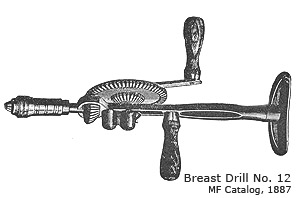 Another
patent, a companion to the one described above, was issued on
the same day with
No. 374,594. It addressed
needed improvement in a chuck "... to hold securely in said
chuck drills and other articles having round shanks."
Another
patent, a companion to the one described above, was issued on
the same day with
No. 374,594. It addressed
needed improvement in a chuck "... to hold securely in said
chuck drills and other articles having round shanks."
The drills with new chucks were shown in Millers Falls Co. tools catalogs for
1886 and 1887. As these dates show, the breast drill with
Goodell's
chuck went into production even before the patent letter
was received.
Other breast drills; No. 10, No. 11, and No. 13 were also
equipped with Goodell's chuck and offered in the 1887 catalog.
The Goodells also participated in the design of more
complex systems. The 1886 Millers Falls catalog shows a Goodell Lathe, designed by Albert D. Goodell, conceivably with
the assistance of his brother Henry E. It incorporates
Scroll Sawing Attachment patented by Albert D. Goodell on
December 15, 1885, with
No. 332,391. The description provided by Millers Falls
Co. is worth reading:
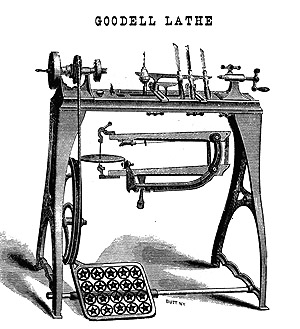 “The lathe was designed by Mr. A. D.
Goodell, for many years the master mechanic at our factory
in Millers Falls, and the inventor of many of our most
valuable machines. It is patterned almost exactly after the
latest improved lathes now used in the best machine-shops
and pattern-makers’ rooms.”
“The lathe was designed by Mr. A. D.
Goodell, for many years the master mechanic at our factory
in Millers Falls, and the inventor of many of our most
valuable machines. It is patterned almost exactly after the
latest improved lathes now used in the best machine-shops
and pattern-makers’ rooms.”
"The lathe head is provided with a two-inch
face-plate, a spur center, a screw center for turning cups,
and also with a very nice drill chuck. The Scroll Sawing
attachment, as seen in the cut, is secured to the lathe bed
by one bolt, and can be put on or off at pleasure."(6)
There were most likely many more tools and
solutions developed during this time, which were not patented.
As an example, the image below shows a ratchet wrench and
Millers Falls Co. named it "Goodell's Ratchet Drills".
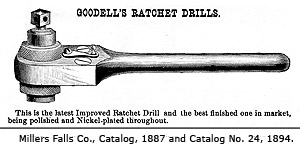 The
tool is not described as patented and indeed no patent is listed
for this design by US Patent Office. Only from the catalog we
know that it was designed by one of the Goodells, most likely
Albert D.
The
tool is not described as patented and indeed no patent is listed
for this design by US Patent Office. Only from the catalog we
know that it was designed by one of the Goodells, most likely
Albert D.
In the next known catalog from 1903, Millers
Falls Co. dropped the Goodell's name and simply called this tool
a Ratchet Drill.
It is also important to remember that many other
tools were developed by Millers Falls Co. during Goodell's
tenure. Among them, hand drills No. 1 and 1B were developed in late
1870s, as well as small
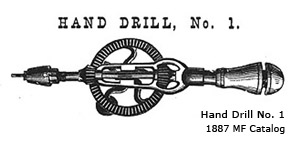 drill No. 4 for jewelry work.
drill No. 4 for jewelry work.
In 1870s Henry L. Pratt, company's president,
developed and patented spring-less chuck for hand drills and
later adopted it for some breast drills. His patent was issued on August 14, 1877
with
No. 194,109.
The first incarnation of the famous medium size hand drill No. 2
was released sometime between 1882 and 1885.
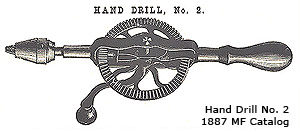 These are only a few examples of many events at
Millers Falls Co. in which the Goodells had a chance to participate.
These developments and the bustling environment of Millers Falls
Co. unquestionably affected Goodell brothers and contributed to
their professional development and future plans.
These are only a few examples of many events at
Millers Falls Co. in which the Goodells had a chance to participate.
These developments and the bustling environment of Millers Falls
Co. unquestionably affected Goodell brothers and contributed to
their professional development and future plans.
Before we explore the future however, a few
summary words need to be said about impact the Goodells had on Millers Falls
Co. I believe that impact was profound. Here are a few points
to consider.
(6) Catalogue,
Millers Falls Company., Hardware Manufacturers, 1886,
(Millers Falls, MA: 1887) 22.